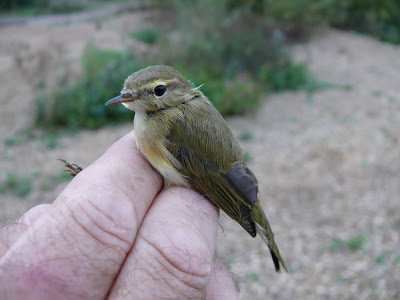We took what we thought was the easy option of driving up Saturday morning but it turned out to be a bit of a slow slog and managed to make it to Cromer about 3pm, then a long wait ensued for some slight high and obscured views of the Greenish and Western Bonelli's Warblers, that were slightly frustrating, with what may our last sighting of five swifts flying over the wood at one stage with a group of Hirundines.
The next day (Sunday) we potentially had been looking at some ringing at Holme NOA but as suspected the westerly wind direction was not a net opener and we arrived at a leisurely 8.30am and ended up chatting to Sophie for an hour or so before deciding to have a wander around. All was relative quite and despite an hour or so at the Red-backed Shrike area in the plantation nothing of the bird was to be seen. Hundreds of Knot on the beach was impressive and we managed to pick up six Manx Shearwaters on the sea, otherwise bird wise it was relative quite.
Heligoland trap Holme
In the afternoon we headed to Titchwell, which compared to our last visit has now some good wader habitat. There was a good mix of autumn waders present with some close Curlew Sandpipers and Little Stint to the path. The sea produced a couple of Arctic and a single Great Skua and a single female/immature Long-tailed Duck.
Juvenile Curlew Sandpiper
A pair of Woodpiegon showing affection
Titchwell freshwater scrape
On Monday we decided to head to Cley, partly drawn by the Red-necked Phalarope and Red-back Shrike, which showed well at the back of Walsy Hill, but the Phalarope had seemingly departed overnight. Cley again had a good selection of autumn waders, along with a group of 14 Spoonbills, and a colour ringed Black-tailed Godwit rung by Pete Potts team in Portugal. One of the hides with rather plagued by the constant noise of DSLR camera shutters going off, made more frequent by the motor drives that after a while left you feeling that you were no longer in what is supposed to be the peace and tranquility of a nature reserve. On the way back to the visitor centre as you crossed the bridge, a medium sized Pike was briefly sitting just by the bridge, but when it decided to move it was so quick you missed it, it had just go with a splash.
Portugese colour ringed adult Black-tailed Godwit
Some of 14 Spoobills, asleep as ever
Pike

























